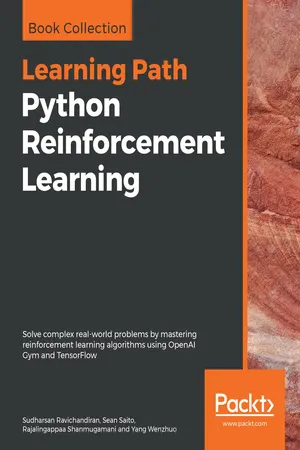
Python Reinforcement Learning
Solve complex real-world problems by mastering reinforcement learning algorithms using OpenAI Gym and TensorFlow
Sudharsan Ravichandiran, Sean Saito, Rajalingappaa Shanmugamani, Yang Wenzhuo
- 496 páginas
- English
- ePUB (apto para móviles)
- Disponible en iOS y Android
Python Reinforcement Learning
Solve complex real-world problems by mastering reinforcement learning algorithms using OpenAI Gym and TensorFlow
Sudharsan Ravichandiran, Sean Saito, Rajalingappaa Shanmugamani, Yang Wenzhuo
Información del libro
Apply modern reinforcement learning and deep reinforcement learning methods using Python and its powerful libraries
Key Features
- Your entry point into the world of artificial intelligence using the power of Python
- An example-rich guide to master various RL and DRL algorithms
- Explore the power of modern Python libraries to gain confidence in building self-trained applications
Book Description
Reinforcement Learning (RL) is the trending and most promising branch of artificial intelligence. This Learning Path will help you master not only the basic reinforcement learning algorithms but also the advanced deep reinforcement learning algorithms.
The Learning Path starts with an introduction to RL followed by OpenAI Gym, and TensorFlow. You will then explore various RL algorithms, such as Markov Decision Process, Monte Carlo methods, and dynamic programming, including value and policy iteration. You'll also work on various datasets including image, text, and video. This example-rich guide will introduce you to deep RL algorithms, such as Dueling DQN, DRQN, A3C, PPO, and TRPO. You will gain experience in several domains, including gaming, image processing, and physical simulations. You'll explore TensorFlow and OpenAI Gym to implement algorithms that also predict stock prices, generate natural language, and even build other neural networks. You will also learn about imagination-augmented agents, learning from human preference, DQfD, HER, and many of the recent advancements in RL.
By the end of the Learning Path, you will have all the knowledge and experience needed to implement RL and deep RL in your projects, and you enter the world of artificial intelligence to solve various real-life problems.
This Learning Path includes content from the following Packt products:
- Hands-On Reinforcement Learning with Python by Sudharsan Ravichandiran
- Python Reinforcement Learning Projects by Sean Saito, Yang Wenzhuo, and Rajalingappaa Shanmugamani
What you will learn
- Train an agent to walk using OpenAI Gym and TensorFlow
- Solve multi-armed-bandit problems using various algorithms
- Build intelligent agents using the DRQN algorithm to play the Doom game
- Teach your agent to play Connect4 using AlphaGo Zero
- Defeat Atari arcade games using the value iteration method
- Discover how to deal with discrete and continuous action spaces in various environments
Who this book is for
If you're an ML/DL enthusiast interested in AI and want to explore RL and deep RL from scratch, this Learning Path is for you. Prior knowledge of linear algebra is expected.
Preguntas frecuentes
Información
Learning to Play Go
- Introduction to Go and relevant research in AI
- Overview of AlphaGo and AlphaGo Zero
- The Monte Carlo tree search algorithm
- Implementation of AlphaGo Zero
A brief introduction to Go
Go and other board games
Go and AI research
Índice
- Title Page
- Copyright and Credits
- About Packt
- Contributors
- Preface
- Introduction to Reinforcement Learning
- Getting Started with OpenAI and TensorFlow
- The Markov Decision Process and Dynamic Programming
- Gaming with Monte Carlo Methods
- Temporal Difference Learning
- Multi-Armed Bandit Problem
- Playing Atari Games
- Atari Games with Deep Q Network
- Playing Doom with a Deep Recurrent Q Network
- The Asynchronous Advantage Actor Critic Network
- Policy Gradients and Optimization
- Balancing CartPole
- Simulating Control Tasks
- Building Virtual Worlds in Minecraft
- Learning to Play Go
- Creating a Chatbot
- Generating a Deep Learning Image Classifier
- Predicting Future Stock Prices
- Capstone Project - Car Racing Using DQN
- Looking Ahead
- Assessments
- Other Books You May Enjoy